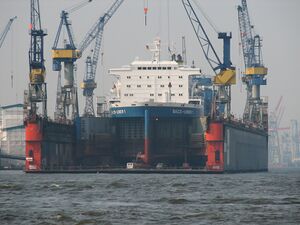Engineering:Baco Liner
 A barge being loaded into a Baco Liner ship in 1994
| |
| Class overview | |
|---|---|
| Name: | Baco-liner |
| Builders: | Nordseewerke |
| Operators: | Seerederei Bacoliner GmbH |
| Planned: | 3 |
| Completed: | 3 |
| Retired: | 3 |
| General characteristics | |
| Type: | LASH ship |
| Tonnage: | 22345 tonnes |
| Length: | 205 m (673 ft) |
| Beam: | 28.5 m (94 ft) |
| Draught: | 6.65 m (21.8 ft) |
| Ramps: | 2 bow doors |
| Speed: | 15 knots (28 km/h; 17 mph) |
| Capacity: | 12 barges with 800 tonnes each |
BaCo Liner an abbreviation for 'Ba'rge - 'Co'ntainer - Carrier, was a shipping service between Europe and Africa owned by Seerederei Bacoliner GmbH of Duisburg, Germany . It used a fleet of specialized barge carrying LASH vessels which have a very unusual design:[1] they carry both conventional shipping containers, and barges that are loaded through twin doors in the bow, a kind of 'float in-float out' arrangement.[2][3]
This system of barges inside a larger ship allowed cargo to be discharged while at anchor mid-stream in African ports, avoiding port delays.[4] The barges could be loaded up to 800 tonnes each, 12 could be loaded per ship. Container capacity was 500-650 TEU.[5]
Each vessel was approx. 205 m long, 28.5 m beam, operating on a loaded draught of 6.65 m. Gross tonnage 22345 tonnes, deadweight 21800 tonnes including 12 barges with 800 tonnes each. Service speed was 15 knots.
In 2007, 24 Filipino crew of a Baco Liner vessel were kidnapped by pirates in Chanomi Creek, Nigeria.[6]
Fleet and fate
The fleet comprised the three barge carriers: BACO-LINER 1, BACO-LINER 2 and BACO-LINER 3, all completed between 1979 and 1984 by Thyssen Nordseewerke GmbH at Emden. They sailed under the Liberian flag, serving ports between Nouadhibou, Mauritania, and Port Harcourt, Nigeria.[7]
BACO-LINER 3 was scrapped in Alang Beach, India, in July 2012. BACO-LINER 2 followed there in June 2013 and BACO-LINER 1 in August 2013. Vessel tracking services now list all three Baco-liners as scrapped.
References
- ↑ Romahn, K (1981). "Baco Liner--a New Type of Ship With Structural Members of Interest With Respect to Welding". Deutscher Verband für Schweisstechnik (Deutscher Verband für Schweißen und verwandte Verfahren e.V.): 68–72. Archived from the original on 4 April 2012. https://web.archive.org/web/20120404172543/http://md1.csa.com/partners/viewrecord.php?requester=gs&collection=TRD&recid=200143003004MT&q=Baco+Liner+a+New+Type+of+Ship+With+Structural+Members+of+Interest+With+Respect+to+Welding&uid=789745983&setcookie=yes. Retrieved 15 August 2010.
- ↑ "Seereederei Bacoliner GmbH - Slideshow". Archived from the original on 2011-07-18. https://web.archive.org/web/20110718201132/http://www.baco-liner.de/sav/slide1/002.html. Retrieved 14 August 2011.
- ↑ Sonstegaard, Miles H. (March 1987). "World standards for shipborne barges". Transportation Research Part A: General (Elsevier) 21 (2): 139–144. doi:10.1016/0191-2607(87)90006-9.
- ↑ Tolofari, S. R. (1981). "The potential for barge-carrying ships: A case study". Transportation Planning and Technology 12 (2): 89–104. doi:10.1080/03081068808717363.
- ↑ "CN Shipping Ltd / Services / BACO Liner". Archived from the original on 8 July 2011. https://web.archive.org/web/20110708171657/http://www.cnship.com/services_baco.htm. Retrieved 14 August 2011.
- ↑ "CHRONOLOGY-Nigerian kidnappings of foreigners in oil delta". Reuters. 26 March 2007. http://uk.reuters.com/article/idUKL2654833420070326. Retrieved 16 August 2010.
- ↑ Lloyd's Register of Shipping. 2005.
External links
 |


